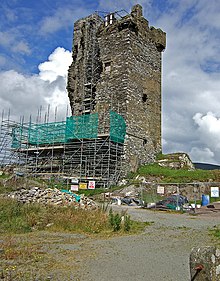Castle Donovan
| Castle Donovan | ||
|---|---|---|
|
Castle Donovan |
||
| Alternative name (s): | Caisleán Uí Dhonnabháin, Castledonovan, O'Donovan's Castle, Sowagh, Sooagh, Suagh | |
| Creation time : | 1560-1584 | |
| Castle type : | Niederungsburg (Tower House) | |
| Conservation status: | ruin | |
| Standing position : | Irish nobility | |
| Construction: | Quarry stone | |
| Place: | Dirmoleague | |
| Geographical location | 51 ° 41 ′ 31.7 " N , 9 ° 16 ′ 58" W | |
| Height: | 144 m ASLTemplate: height / unknown reference | |
|
|
||
Castle Donovan ( Irish Gaelic : Caisleán Uí Dhonnabháin ), also Castledonovan or O'Donovan's Castle , the ruins of a tower house in a valley near the village Dirmoleague in Irish County Cork . For a time in the 16th century, the castle was the seat of the Clann-Cathail clan of the O'Donovan family . The original name of the castle, when the O'Donovans lived there before the 17th century, was "Sowagh" (also "Sooagh" or "Suagh"). The name "Castle Donovan" after the Manor of the Castle of O'Donovan is associated with the reassignment by King James II of England in 1615. Castle Donovan sits about 18 meters high on a large rock that forms the ground floor on the banks of the River Ilen . It is believed that it was built, or at least expanded, from 1560 to 1584 for Donal of the Hides, Lord of Clancahill . His son, Donal II. O'Donovan , had the building repaired and altered a few decades later, but did not live there at the time. It is thought that his father moved the family seat to the more profitable Rahine Manor on the seashore in the first decade of the 17th century to defend the family's maritime interests.
Legend has it that the Tower House was badly damaged and powdered by the soldiers of Oliver Cromwell in the late 1640s in revenge for Donal III. O'Donovan joined the House of Stuart for his involvement in the rebellion and massacre of 1641; since then it has been uninhabitable.
In 1834 Philip Dixon Hardy published a report in the Dublin Penny Journal about his trip to the "Vale of Castle Donovan" in 1828 and enclosed a drawing showing many of the outbuildings. He wrote:
“(...) It is difficult to think of anything more wild, desolate or lonely than this wild valley. (...) I reached the height that dominates it from the east, around two [o'clock] in the afternoon on a warm, sunny day. There are no trees in the area and the heather-like vegetation on the hills could not show any signs of the advanced season. In the middle of the valley below me was the tall, fortified tower; an extensive, damp meadow lay behind it, bounded by the steep, rocky hills of Mullaugh-Nesha and her pointed brothers. "
The enclosure of the Tower House and the outbuildings no longer exist, but more than 2/3 of the tower have been preserved. The explosion in the 17th century left only a small splinter on the southwest corner, but caused huge cracks in the masonry, which meant that the whole tower was no longer stable. Over two centuries later, the entire western wall (with the exception of the spiral staircase) and much of the southern wall collapsed. Between 2001 and 2014, Castle Donovan was secured by the Office of Public Works . Castle Donovan is listed as a National Monument.
Individual references and comments
- ↑ The ruins of the main family residence on this country estate are called Raheen Castle ; they are in Myross at the port of Castlehaven .
- ^ The Dublin Penny Journal . Pp. 137-139. 1835. Retrieved June 28, 2018.
- ↑ Mike Searle: Photos of Castledonovan Castle during restoration . 2007. Retrieved June 28, 2018.
- ↑ Dáil Éireann - 22 January 2014 - Written Answers Nos. 82-90 - Public Procurement Regulations - Office of Public Works Projects . Houses of the Oireachtas (Hansard). January 22, 2014. Accessed June 28, 2018.
swell
- Constance Louisa Adams, Lucius O'Brien (Illustrations): Castles of Ireland: Some Fortress Histories and Legends . Elliot Stock. London 1904. Retrieved June 28, 2018.
- WFT Butler: The Barony of Carbery in Journal of the Cork Historical and Archaeological Society Volume X, Second Series . Pp. 1-10, 73-84. 1904. Retrieved June 28, 2018.
- Michael J. Carroll Alan Langford (Illustrations): The Castles and Fortified Houses of West Cork . Bantry Design Studios, 2001.
- Daniel Donovan: Sketches in Carbery, County Cork. Its Antiquities, History, Legends, and Topography . McGlashan & Gill. Dublin 1876. Retrieved June 28, 2018.
- Elizabeth FitzPatrick: Royal Inauguration in Gaelic Ireland c. 1100-1600: A Cultural Landscape Study . Boydell Press, 2004.
- Philip Dixon Hardy: Castle Donovan in The Dublin Penny Journal. Volume III. Issue 122 . Pp. 137-139. November 1, 1834. Retrieved June 28, 2018.
- Caroline Legrand: You tourisme généalogique dans l'Irlande contemporaine . In: Revue de Synthèse . Pp. 131-147. December 2002. Retrieved June 28, 2018.
- Caroline Legrand: La quête de parenté. Pratiques et enjeux de la généalogie en Irlande . Presses Université Laval, Québec 2006.
- John O'Donovan (editor and translator): Annala Rioghachta Eireann. Annals of the Kingdom of Ireland by the Four Masters, from the Earliest Period to the Year 1616 . 7 volumes. Royal Irish Academy, Dublin 1848-1851. 2nd edition 1856. Volume VI : Pedigree of O'Donovan . Pp. 2430-2483.
- Diarmuid Ó Murchadha: Family Names of County Cork . 2nd Edition. The Collins Press, Cork 1996.


